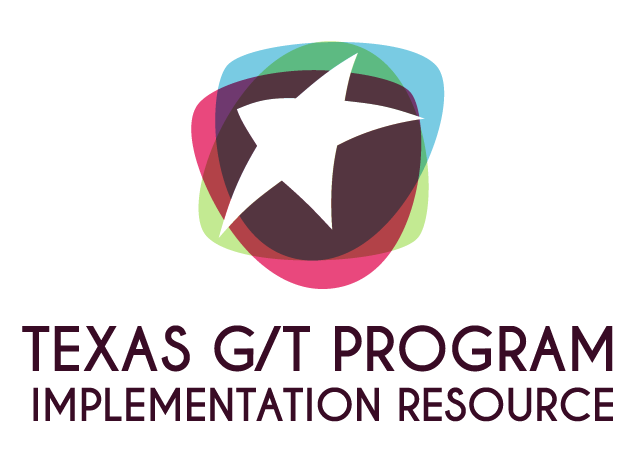Student Assessment
School districts with high-quality gifted/talented (G/T) programs have written policies on their student identification process and procedures. These were approved by the board of trustees. These policies and procedures included an identification time line, policies on transfer students, furloughs, reassessment, and exit and appeal procedures. Every decision was aligned to the Texas State Plan for the Education of Gifted/Talented Students.
Assessment criteria are determined based on the population of the district and the type of giftedness being served. Many G/T programs are serving the general intellectual needs of the G/T. The following G/T Identification Process Chart generally describes the process many of these schools follow with their G/T identification. The timeline for this process is usually developed in the late spring semester for grades 1 through 12 to prepare for the next academic year. The screening results are shared with principals so that schools can prepare for students’ appropriate placement in the following school year. Kindergarten screening and identification can begin as early as late November because students are to be identified before March 1. A district will not receive funding for those identified kindergarten students if they are not recorded in the Public Education Information Management System (PEIMS) before March 1. TEA Student Attendance Accounting Handbook
Awareness
- Before the nomination period begins, meet briefly with faculty and staff to share the characteristics of G/T students.
- Conduct an awareness session with parents about the characteristics of a G/T child. Talk with parents about program and timeline.
Nomination
- Announce nomination periods to community, parents, and teachers.
- Provide parents and teachers with the appropriate forms to nominate potential gifted students.
Screening
- Collect at least three pieces of criteria including qualitative and quantitative data on each student (five criteria is the norm).
- Place data on a profile or a matrix.
Selection
-
Select or group at least three trained local school district employees to serve on the committee. This usually includes a counselor, principal, G/T teachers, and/or G/T coordinator. Trained members would have six hours of nature and needs training completed.
- Make a selection, based on the preponderance of the data, of who will be included in the program.
Determination of Placement
- If a student is selected, then send home a permission slip to be signed by a parent. Permission must be received to place a PEIMS identification label on a student.
- If a student is not selected, send home a letter stating that information. Parents have the right to appeal the committee’s decision.
Participation
- Place students in the appropriate G/T services with G/T trained staff within a district guidelines.
- Decide whether you will have reassessments during a child’s school career. This is usually done before the student enters secondary schools. Most small school districts do not have a reassessment period because of time and lack of personnel. Once students are identified, they stay identified.
- Prepare exit or furlough procedures in the event a child is misplaced, not happy, or failing the G/T program. Reminder: these are district policy decisions and not campus decisions.
Refer to the Texas State Plan for the Education of Gifted/Talented Students under the Recommended and Exemplary columns for guidance on best practices on student assessment. Among these practices are that assessment opportunities for G/T identification be made available all year, all kindergarten students be screened, identified students closely reflect the demographics of the population of the total district, the selection committee may have additional G/T training, and districts maintain communication with parents about these processes and procedures.
Forms
- G/T Exit Committee Report
- G/T Furlough Policy and Referral Form
- Parent Permission Form (English) (Spanish)
- Identification Matrix
Qualitative Measures Qualitative measures are performance indicators that include observations, anecdotal records, checklists, interviews, student products, and performances. Some districts are using a district-generated inventory for parents or teachers based on other inventories in the field.
Inventories (examples)
- Scale for Identifying Gifted Students (SIGS) Renzulli-Hartman Rating Scale
- Gifted Rating Scale (GRS)
- Traits, Aptitudes & Behavior (TABS)
- Gifted and Talented Evaluation Scales (GATES)
Quantitative Sources Quantitative sources are performance indicators that can be expressed in definite numbers or amounts such as norm-referenced achievement or ability tests.
Ability (examples)
- Nagligeri Nonverbal Ability Test (NNAT)
- Sages
- CoGat
Achievement (examples)
- Iowa Tests of Basic Skills (ITBS)
- Stanford 9 Apprenda
Resources
Public Announcement for G/T Referral
This is a sample notification to announce the dates for the G/T referral process.
G/T Referral Form
This is a sample form to use when referring a student for G/T identification.
Identification Matrix
This is a sample of a completed G/T identification matrix.
Identification Decline Letter
This is a sample of a letter to send parents of a student who did not qualify for G/T services.
Parent Permission Form for G/T Services
This is a sample permission form to send to parents/guardians of a student who qualifies for G/T services.
Links
Equity in Gifted/Talented (G/T) Education is a state initiative that has many resources districts can refer to for identification. There are many bilingual tools on the site as well as a list of standard assessments.
https://gtequity.tea.texas.gov/
Disclaimer
The document templates on this site feature the fictitious district Mockingbird ISD. These forms are downloadable and can be customized for district use as appropriate.
